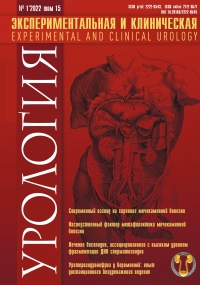Introduction. Excess body weight and obesity are significant risk factors for the development of urinary incontinence in women and can negatively affect the outcomes of surgical treatment. There is a large number of publications in international literature dedicated to the topic of surgical treatment of stress urinary incontinence in patients with morbid obesity. Domestic publications on this topic are severely limited.
Purpose. To evaluate the effectiveness of transobturator access in the treatment of stress urinary incontinence in patients with morbid obesity.
Materials and methods. The effectiveness and safety of loop urethral plastic surgery by transobturator access was evaluated in 41 patients with morbid obesity. The average age of the patient was 61 (54-65) years, body mass index 39,1 (37,4-40,3) kg/m2. All patients underwent loop plastic surgery of the urethra using a mesh synthetic endoprosthesis using. All patients underwent a comprehensive general clinical examination, as well as additional methods, including: filling out questionnaires, vaginal examination, cough stress test, uroflowmetry, ultrasound of the bladder to determine the volume of residual urine, bacterialsowing urine.
Results. At the maximum follow-up period, 6 (14.6%) patients had a positive cough stress test. Recurrence of the disease in 1 month after surgery was observed in 4 (9.7%) patients and in 2 (4.8%) after 3 months. The development of urgent in the immediate postoperative period was registered in 4 (9.7%) patients, 2 (4.8%) patients experienced acute cystitis. The results of the surveys revealed a significant improvement in the quality of life and general well-being after surgical treatment. The parameters of the urodynamic study did not reveal signs of obstructive urination and an increase in the amount of residual urine.
Conclusion. Loop urethroplasty performed via the transobturator approach is a safe and relatively effective method of surgical treatment of stress urinary incontinence in patients with morbid obesity.






